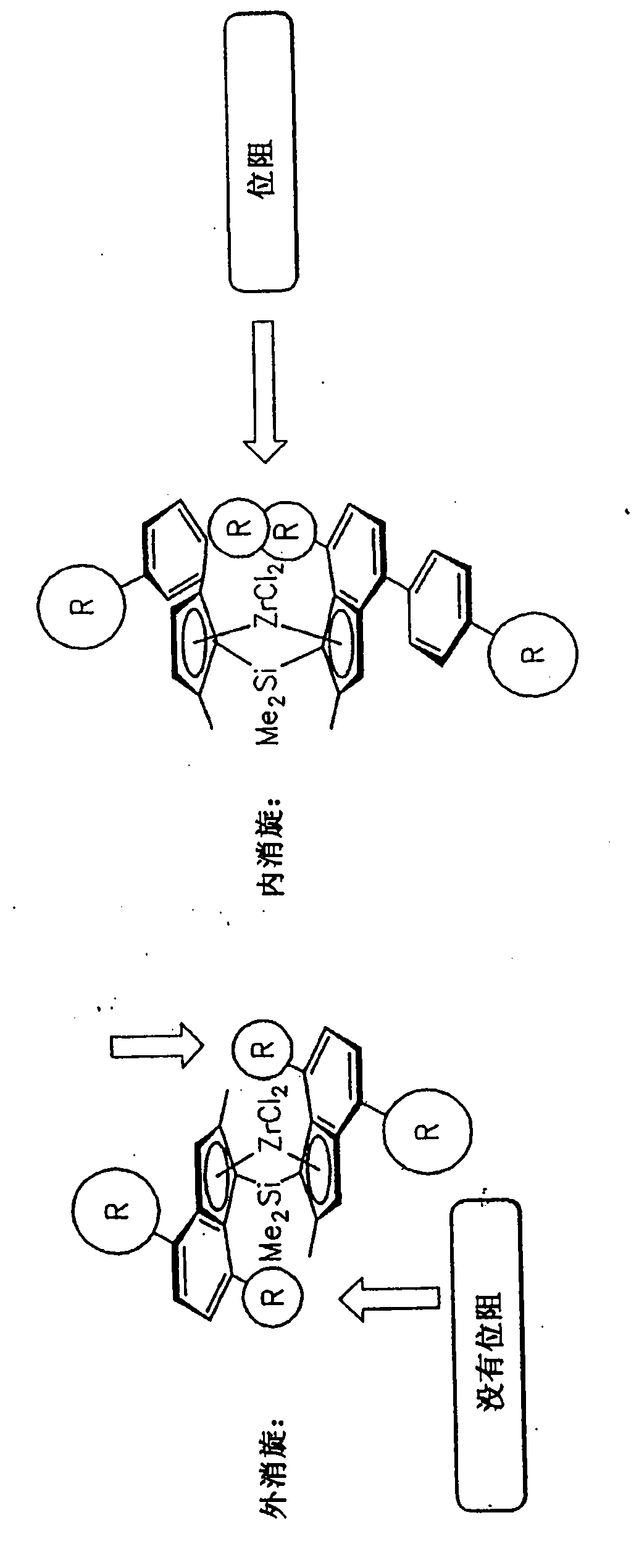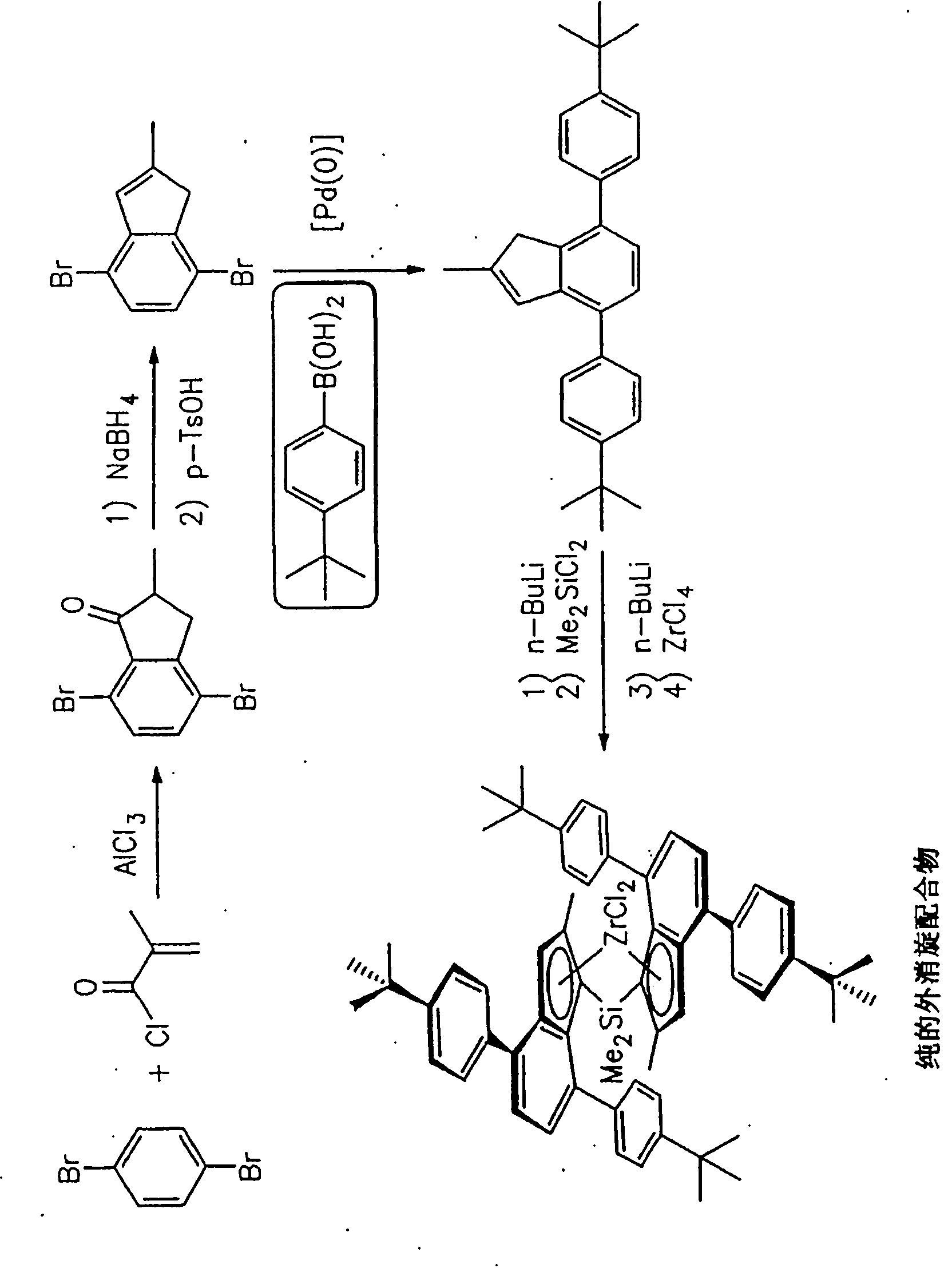Racemoselective synthesis of ansa-metallocene compounds, ansa-metallocene compounds, catalysts comprising them, process for producing an olefin polymer by use of the catalysts, and olefin homo- and copolymers
A metallocene compound, catalyst technology, applied in racemic selective synthesis of ansa metallocene compounds, ansa metallocene compounds, catalysts containing the compounds, preparation of olefin polymers and olefin homopolymers by using the catalysts and the field of copolymers, which can solve problems such as increasing synthesis steps
- Summary
- Abstract
- Description
- Claims
- Application Information
AI Technical Summary
Problems solved by technology
Method used
Image
Examples
Embodiment 1
[0440] Dimethylsilanediylbis(2-methyl-4,7-bis-(4-tert-butyl-phenyl)-indenyl)zirconium dichloride
[0441] 4,7-Dibromo-2-methyl-indan-1-one
[0442]
[0443] In a 1000 ml round bottom flask equipped with a mechanical stirrer, 94.37 g (0.40 mol) of 1,4-dibromobenzene and 106.7 g (0.80 mol) of anhydrous aluminum trichloride were placed. 62.72 (0.60 mol) of 2-methyl-acryloyl chloride were added exothermicly (50-55° C.). The mixture was heated and strong gas evolution was observed starting from 105°C and the temperature rose to 135°C. Heating of the now solid material was continued at 110 °C for 3 h. After cooling to room temperature, 200 g of ice were heated very carefully, followed by careful addition of 200 ml of concentrated hydrochloric acid. The mixture was extracted 3 times with 250 ml of dichloromethane each time. The combined organic layers were washed with 250 ml of water and 250 ml of saturated sodium bicarbonate solution, dried over magnesium sulfate, and the s...
Embodiment 2
[0457] Dimethylsilanediylbis(2-methyl-4,7-bis-(1-naphthyl)-indenyl)zirconium dichloride
[0458] 4,7-bis-(1-naphthyl)-2-methyl-1H-indene
[0459]
[0460] Place 17.6g (61.1mmol) 4,7-dibromo-2-methyl-1H-indene in 500ml round bottom flask, 26.3g (2.5 equivalents) 1-naphthyl boronic acid, 274mg (2mol%) palladium acetate, 42.23 g (2.5 equivalents) of potassium carbonate, 39.4 g (2 equivalents) of tetrabutylammonium bromide, 169 ml of degassed water and 169 ml of degassed toluene. The mixture was stirred at reflux for 20h. After cooling to room temperature, 100 ml of toluene and 100 ml were added. The aqueous phase was extracted 3 times with 100 ml toluene. The combined organic layers were washed once with 100 ml of 2M sodium hydroxide solution and three times with 50 ml of water each time and dried over magnesium sulfate. The solvent was removed in vacuo and purification by flash chromatography on silica using heptane / dichloromethane (10:1) afforded 15.3 g (40 mmol, 65%) ...
Embodiment 5
[0477] To a stirred suspension of 293 g of silica (Grace XPO2107, dried at 180° C. and 1 mbar for 16 hours, LOD < 0.5% by weight and LOI = 2.6% by weight) in 1500 mL of toluene was added slowly at room temperature 300 mL of 30 wt. % of methylalumoxane in toluene (Albemarle Corporation). During the addition, the temperature must not exceed 30°C. After the addition was complete, the mixture was stirred at room temperature for 2 hours and separated by filtration. The residue was washed with 2 parts of 1500 mL of toluene and with 3 parts of 1500 mL of isohexane and dried in vacuo to constant weight. The methylaluminoxane-treated silica was obtained in the form of a free-flowing powder in a yield of 408 g.
[0478] Preparation of Supported Metallocene Catalysts:
PUM
| Property | Measurement | Unit |
|---|---|---|
| specific surface area | aaaaa | aaaaa |
| specific surface area | aaaaa | aaaaa |
| specific surface area | aaaaa | aaaaa |
Abstract
Description
Claims
Application Information
 Login to View More
Login to View More - R&D
- Intellectual Property
- Life Sciences
- Materials
- Tech Scout
- Unparalleled Data Quality
- Higher Quality Content
- 60% Fewer Hallucinations
Browse by: Latest US Patents, China's latest patents, Technical Efficacy Thesaurus, Application Domain, Technology Topic, Popular Technical Reports.
© 2025 PatSnap. All rights reserved.Legal|Privacy policy|Modern Slavery Act Transparency Statement|Sitemap|About US| Contact US: help@patsnap.com



